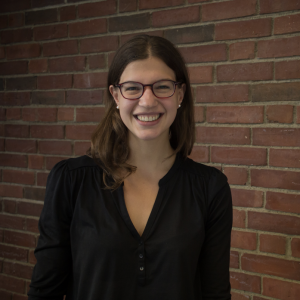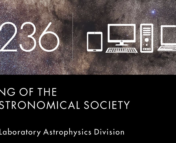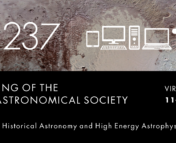In this series of posts, we sit down with a few of the keynote speakers of the 238th AAS meeting to learn more about them and their research. You can see a full schedule of their talks here, and read our other interviews here!

Dr. Jenny Bergner. Image courtesy of Dr. Bergner.
If you were asked to find a chemist, you would probably think to look in the local lab for someone holding an Erlenmeyer flask. If you were asked to find an astronomer, you’d probably search the local observatory for someone looking through the telescope. If you were asked to find Dr. Jenny Bergner, winner of the 2021 Laboratory Astrophysics Division Dissertation Prize, you’d have equal odds of finding her in either location!
The Terrestrial Origins of Astrochemistry
Dr. Jenny Bergner is an astrochemist and Hubble Sagan Postdoctoral Fellow at the University of Chicago. A chemist by undergraduate training, she described how a seminar on astrochemistry opened her eyes to new research pathways in chemistry beyond the Earth: “I [had] just spent three and a half years learning about how I thought chemistry works, and [then] there was all this space chemistry that I [didn’t] understand.” This spark of interest launched her into an astrochemistry Ph.D. where she could further develop her passion. “Astrochemistry is exciting because we get to take some of the tools that we use in regular chemistry, but apply it to these exotic regions in space where the chemistry plays out really differently from how it does on Earth.”
Furthermore, she enjoyed the different environments that studying astrochemistry exposed her to. “During grad school, I spent about half of my time in the lab and half of my time doing observations, so that was a really nice balance for me. I definitely recommend that to people thinking about grad school: [think about] ways that you can have multiple things going on. It’s fun to look at the problem from different perspectives and try to make different connections.”
Space Ices and Why They’re So Cool
A question that astrochemistry is particularly suited to answer is one of planet and star formation and habitability. Astrochemists can use the tools of regular chemistry to study how molecules are formed and inherited along the star and planet formation sequence, something that Dr. Bergner is particularly interested in understanding.
One very useful tool for Dr. Bergner has been a lab with a vacuum chamber that can simulate the conditions of space, with a temperature of around 10 Kelvin and at 13 orders of magnitude below atmospheric pressure—conditions found in the interstellar medium! “We can study in a really controlled way how the chemistry plays out in these very exotic environments,” Dr. Bergner explained. In particular, she tracked the behavior of volatile molecules—aka, molecules that are light and prefer to be in the gas phase like hydrogen, carbon, nitrogen, and oxygen. In cold and dense environments, these volatile molecules will freeze out onto the surfaces of tiny dust grains present in the interstellar medium. “These ice mantles basically are the sites where a lot of organic chemistry can happen,” Dr. Bergner continued. “I did a series of experiments during my Ph.D. trying to understand kind of unexplored pathways for producing organic molecules within these ices, so I’m going to be talking about one of these pathways which I think is pretty exciting.” This particular pathway is an unusual type of chemistry, and it involves photons in the interstellar medium breaking up the ices in a way that allows the freed oxygen atoms to produce more complex organic compounds by inserting themselves directly into hydrocarbons. “The whole game at 10 Kelvin is [that] there’s not a lot of extra thermal energy around,” Dr. Bergner continued, explaining that the influx of energy coming from the photon is what allows these chemical reactions to take place. “How volatile chemistry in the early stages of star formation might subsequently impact the compositions of planets that are forming, and this has fun implications for things like planetary habitability.”
The Chemistry of Habitable Non-Obscured PlanetS (CHNOPS)
Sure, the section header I came up with above is cumbersome and slightly superfluous, but the acronym is absolutely vital for life as we know it. “When we think about life on Earth, there are six elements that are sort of the lowest common denominator: carbon, hydrogen, oxygen, nitrogen, phosphorus, and sulfur (CHNOPS),” Dr. Begner explained. In her research, an especially interesting part of the acronym is the letter P, relating planets with phosphorus: “Of these [elements], we can study all of them except for phosphorus really easily along the entire star formation and sequence, because they are gasses and […] easy for us to detect using millimeter astronomy. But phosphorus is sort of the oddball in that. It tends not to be in the gas phase […], so our understanding of the phosphorus chemistry leading up to planet formation is very rudimentary.” Nevertheless, progress is being made: Dr. Bergner is still very actively working on detecting celestial phosphorus, including mapping its sources and emission in the sky and what molecules it is associated with.
Advice from an Astrochemist
As a recently minted postdoc, Dr. Bergner is loving her job. “What I like best is that I get paid to do astronomy. I really like the kinds of questions that we can ask and the coolness of being able to study regions in space where other planetary systems are forming. This is very exciting to me!” When asked about advice for undergraduates considering graduate school, Dr. Bergner underlined the importance of following one’s interests and a supportive environment. “I had a really great experience in grad school, in large part probably because I got along with my Ph.D. advisor really well, and I think that that can really make or break a person’s Ph.D. experience. So do what you think is exciting but also do it with people who are going to support you and keep you happy!”
To hear more about astrochemistry, planetary formation, and the coolest ices in the universe, be sure to attend Dr. Bergner’s prize lecture at 4:40 PM ET on Tuesday, June 8 at #AAS238!
Astrobite edited by Sabina Sagynbayeva
Featured image credit: AAS



